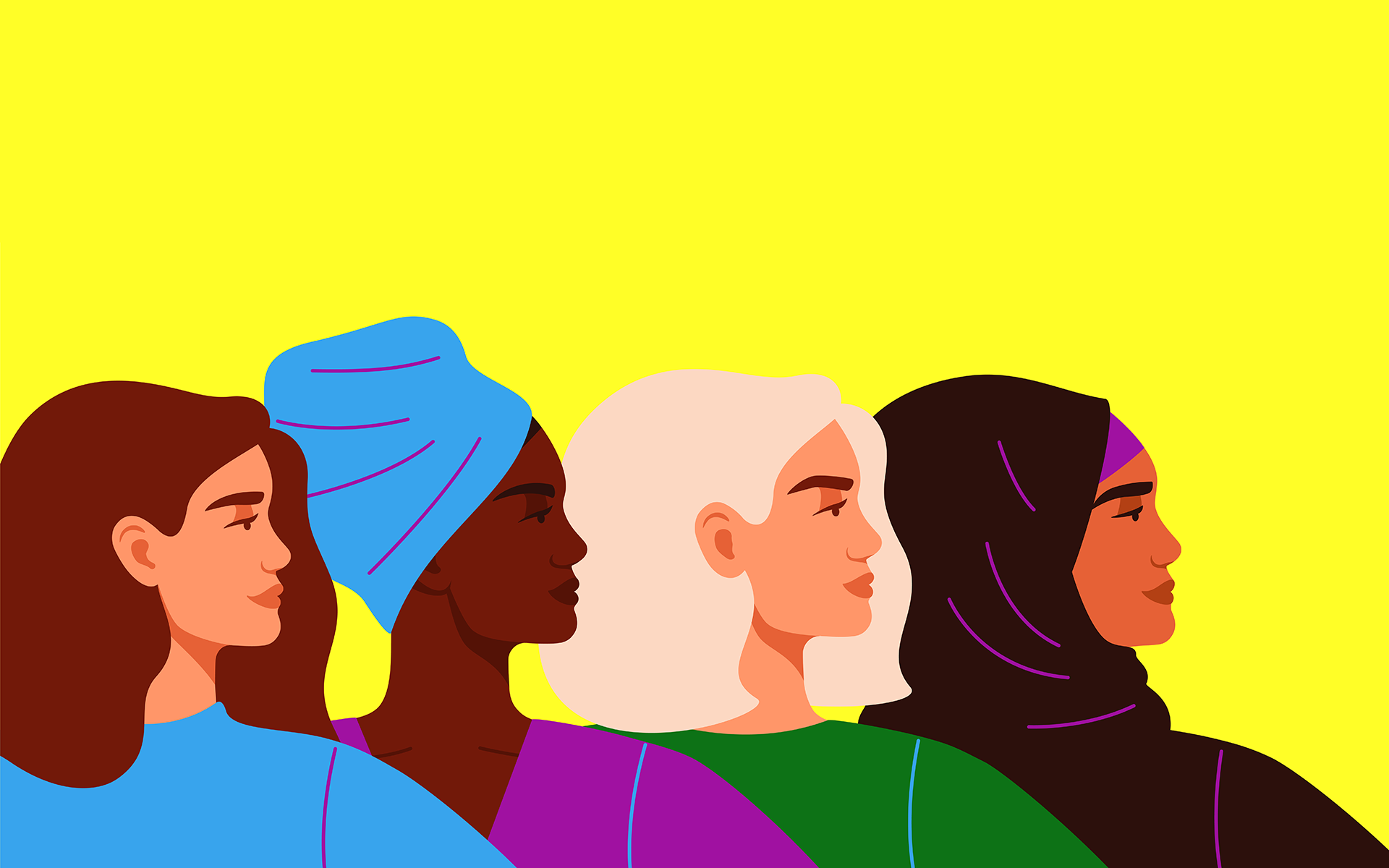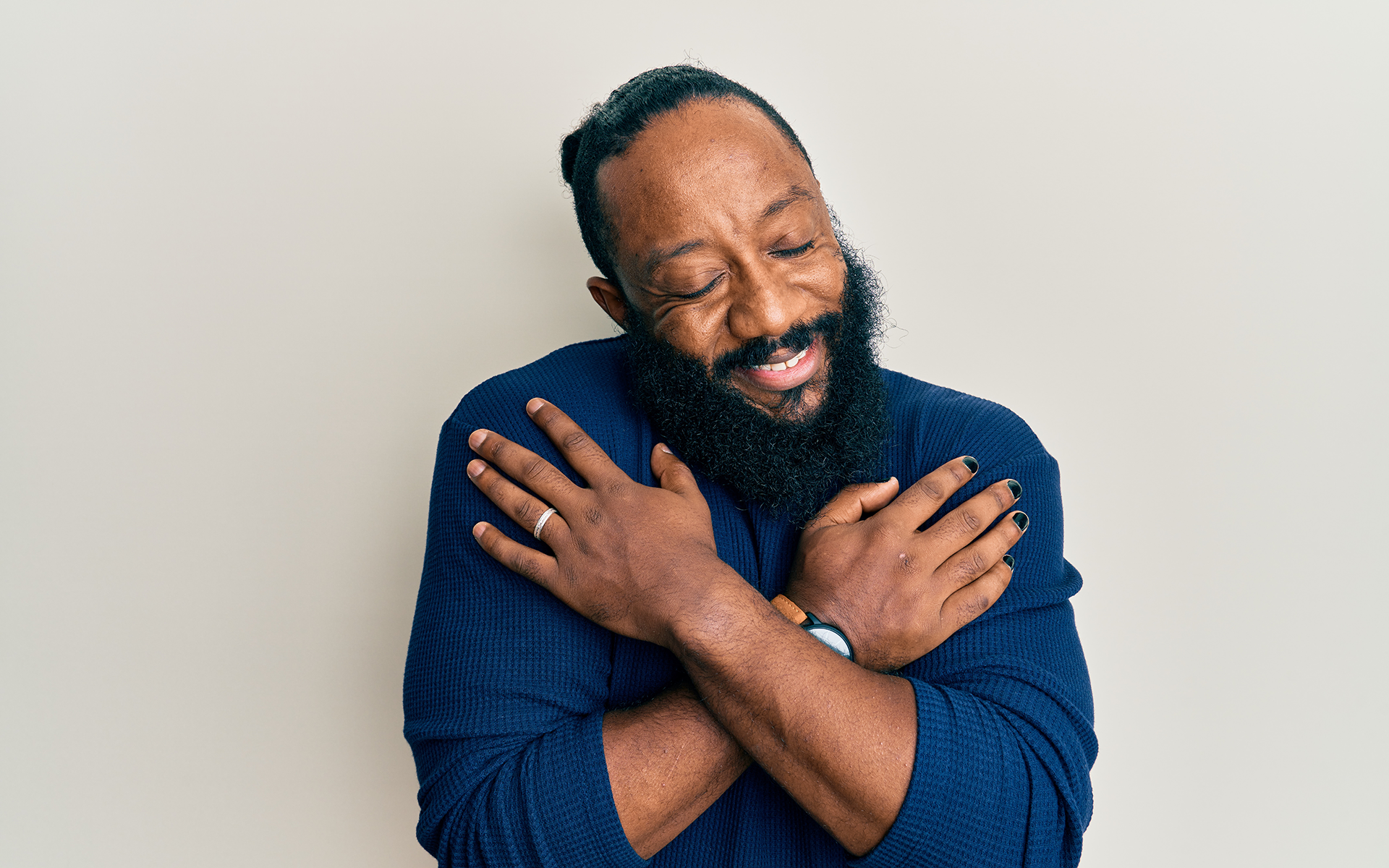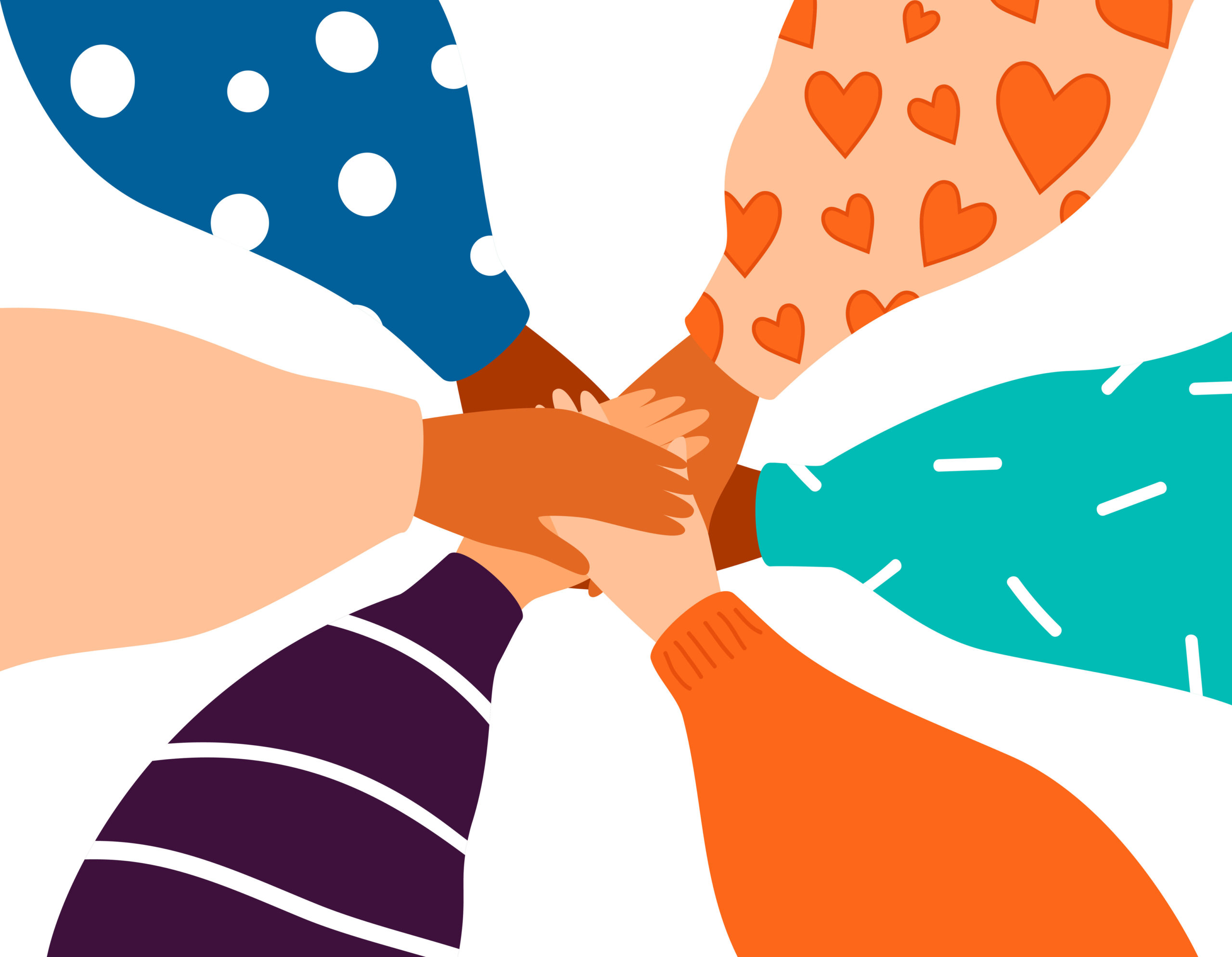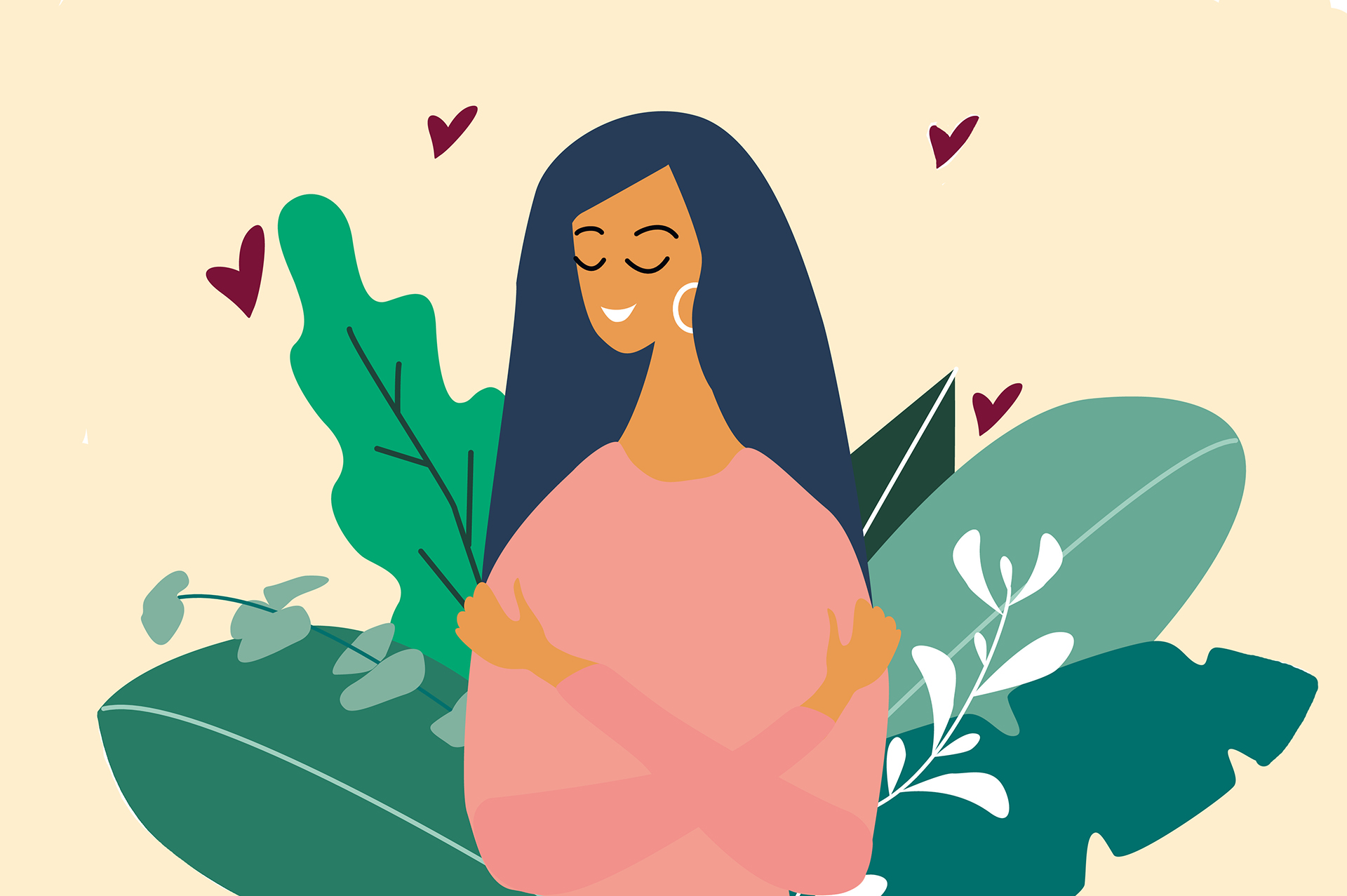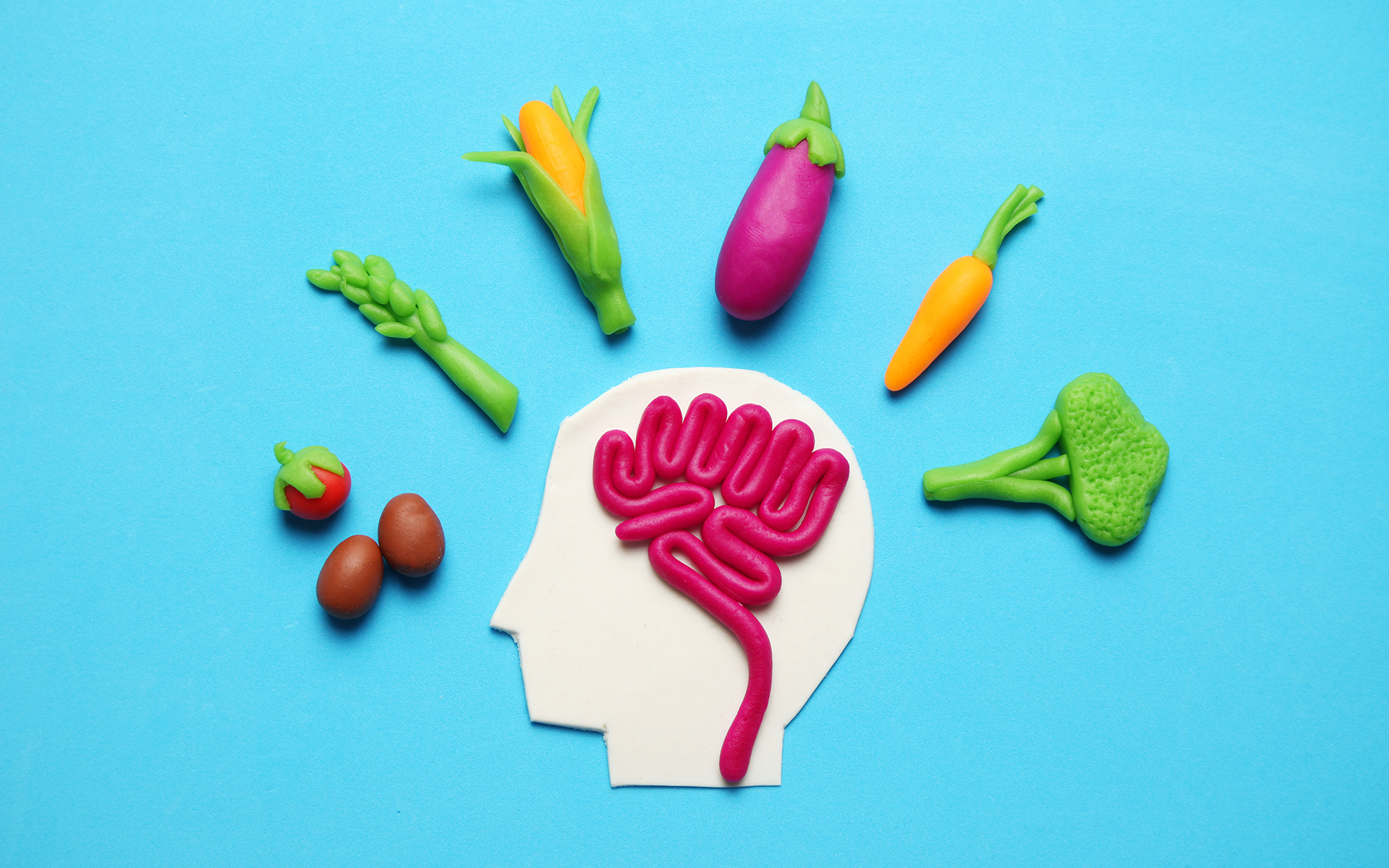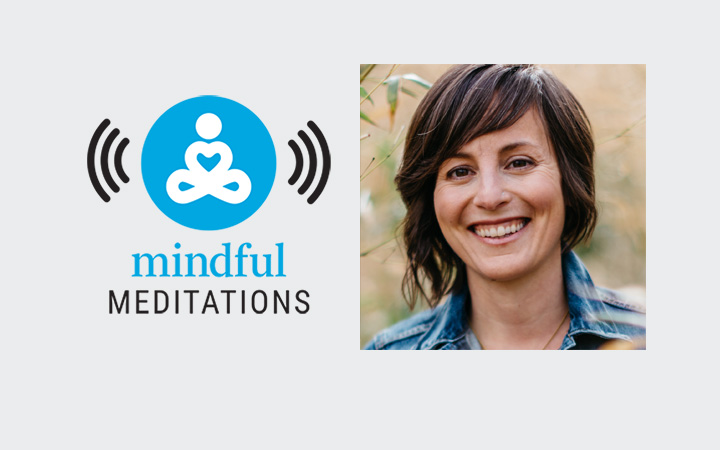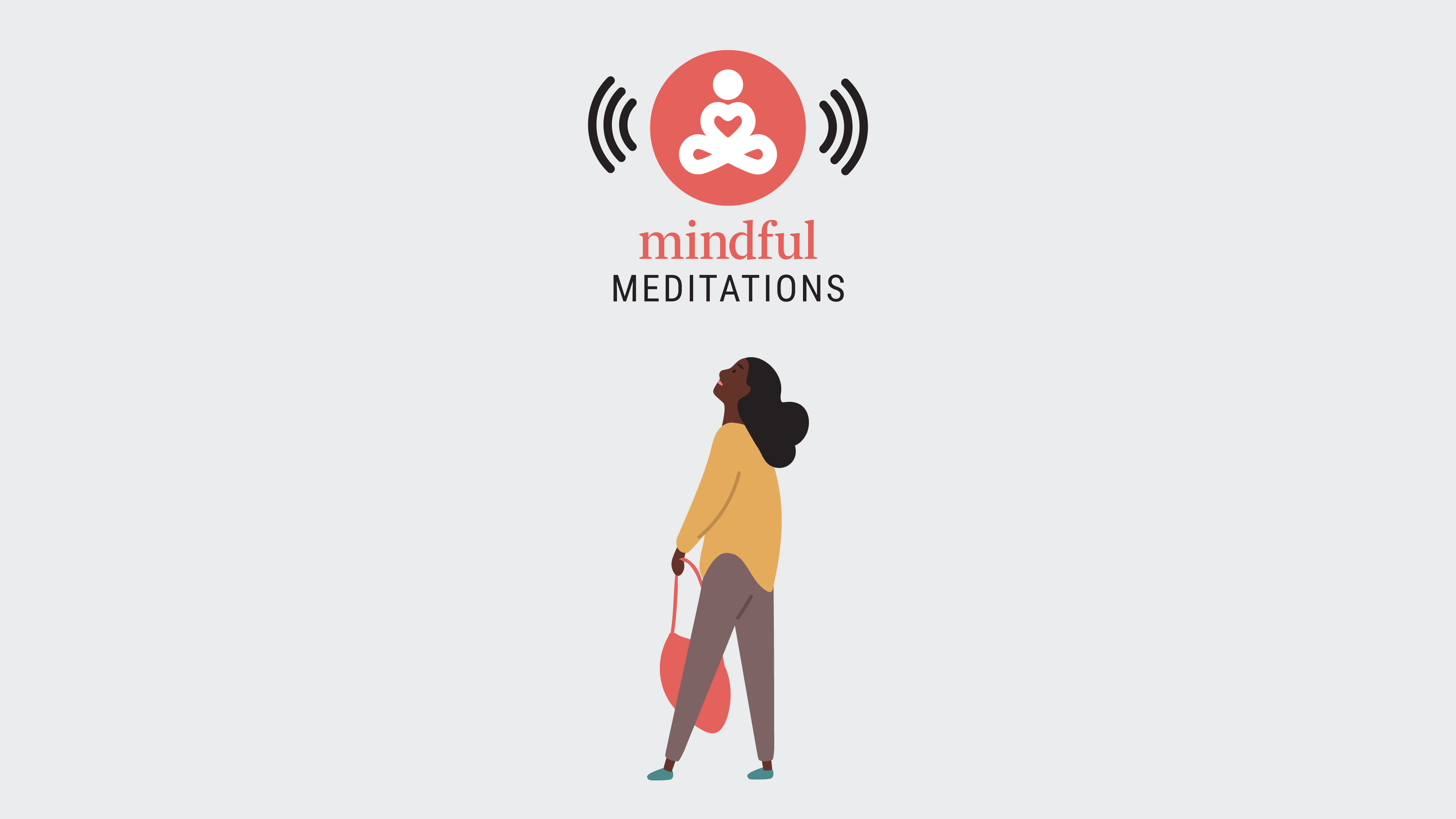
In celebration of International Women’s Day, we’ve gathered guided meditations from some of the powerful women of the mindfulness movement. Here they share their deep practice with you so you can be inspired not only to sit and practice, but also to rise and act.
1) A 10-Minute Meditation to Cultivate Embodied Awareness

Sebene Selassie
Mindfulness Teacher, Author, and Speaker
“Mindfulness presents the opportunity for us to be more fully present for ourselves, our loved ones, and the earth.”
Read and practice the guided meditation script below, pausing after each paragraph. Or listen to the audio practice.
A 10-Minute Meditation to Cultivate Embodied Awareness
Guided Meditation:
- Take a moment to find a comfortable position. You don’t need to be in a particular posture. You can be standing, sitting, or even lying down. The most important thing is that you feel relaxed and alert. Make sure that you have some openness in the front of your body. You can roll your shoulders up and back. Or if you’re lying down, just allow your shoulders to really relax into the floor. You want to have some uprightness or length in your spine without being rigid or stiff. And you want to invite a softness into the face, the jaw, the shoulders, and the belly. This balanced posture of being both relaxed and alert, being both soft and open, is the beginning of our embodied awareness.
- Notice how the body is feeling in this moment. You don’t need to change anything about the mind, your thoughts, the heart, your emotions, the body, or any sensations. Just simply allow what’s happening to be in your awareness. How does your body feel right now?
- Feel what’s going on physically or mentally. What sensations are you experiencing? Where may there be tightness or tension in the body? And where is there ease or relaxation? Just notice what’s here. As you continue to settle into this embodied awareness, you can close your eyes if you’d like, or keep them open as you continue to rest your awareness on the body.
- Just notice what’s present, and allow what’s happening. Maybe there are thoughts or emotions coming up. Just let everything be here. Now, I’m going to invite you to take a deep breath in through the nose, and as you exhale, you can even make a sighing sound. Release any tension in the body as you breathe in and out. Do this a few times on your own as you breathe in, opening the front of the body, and as you breathe out, really softening and relaxing. Allow the breath to come to its natural rhythm, and just take a moment in silence to notice your bodily sensations. You don’t have to think about the body, but really feel any sensations or vibrations.
- Now, see if you can feel the contact with what’s supporting your body right now. It could be a chair, a cushion, a bed, or the floor or ground beneath you. Just really sense into your feet or seat, allowing yourself to feel grounded. Continuing to sense the connection with what’s underneath you, bring awareness to the pressure or the weight of the body. What is that sensation like?
- Even now, thoughts or concerns might be coming up, and this isn’t a problem. The mind thinks about the past or the future, and comments on the present. That’s what it does often. But the body is always in the present moment. And if thinking happens, just allow your awareness to rest back into an awareness of the body.
- Now, bringing your awareness to the breath as it flows in and out of the body, you might want to take one or two deep breaths in and out through the nose to connect you to this process that’s always happening (whether we pay attention or not). You can notice the belly rising and falling as you breathe in and out. If you’re having trouble connecting to the sensation, you can place one or both hands over your belly button to feel the belly rising on the inhale and falling on the exhale. If the breath is hard for you to follow, you can rest your awareness on the body’s contact with what’s underneath you, or on any part of the body that brings you a sense of ease of connection.
- If you’re staying with the breath, continue to notice the inhale and the exhale. Embodied awareness is a way for us to stay with our experience by using the body, the breath, or any sensory experience as a way to connect to the present moment. Not by pushing away thoughts or emotions, but by allowing the body to be the ground for our awareness. Just take a moment in silence to rest in this embodied awareness.
- As we end this meditation, take a moment to express gratitude toward yourself for taking time to cultivate this practice. And know that in any moment you can reconnect to the body, the breath, the sense of groundedness as a way to create spaciousness, ease, and rootedness. You can open your eyes now, and begin to move your hands and feet. Let yourself reconnect to your surroundings as we finish this meditation.
2) A 10-Minute Meditation for Deep Relaxation

Jenée Johnson
Mindfulness, Public Health, and Racial Healing Innovator
“Once you have access to the fullness of your worth and your humanity, then you can do just about anything you want.”
Read and practice the guided meditation script below, pausing after each paragraph. Or listen to the audio practice.
A 10-Minute Meditation for Deep Relaxation
Guided Meditation:
- Sitting in an upright but relaxed position, drop your gaze or close your eyes. Take a deep breath in and an audible exhale out. Breathing in and breathing out, sitting quietly, free floating, invite your body to relax.
- When we simply sit and breathe, we activate the body’s calming response. It allows the brain to display the calm, smooth, harmonious waves called alpha brain waves—like the waves of the ocean, coming in to the shore and rolling back out. Coming in and going out. Breathing in and breathing out. Relax.
- Drop your shoulders, relax the jaw, and unfurl your brow. Allow your mind to float freely until it settles down. Let thoughts come and go as they please.
- Bring your attention back gently to your breath. Don’t exert yourself trying to block thoughts. Just remain passive and remind your body that we’re sitting now, we’re breathing now, we’re relaxing now. Sit quietly, stay with your breath. Like the waves of the ocean, breathing in, breathing out. Let thoughts fade into the background. Relax. To be still, to be quiet, to be at ease. This is the gift of relaxation.
3) A 20-Minute Practice to Hold the Emotional Body

Leslie Booker
Yoga and Meditation Teacher, Speaker, and Author
“I want you to see my color. I want you to know that I’m queer. I want you to know that I’m racialized and politicized.”
Read and practice the guided meditation script below, pausing after each paragraph. Or listen to the audio practice.
A 20-Minute Practice to Hold the Emotional Body
Guided Meditation:
- Find a comfortable posture—walking, standing, lying down, or seated. With open eyes, move the head side to side, breathing in and pausing when the chin is over a shoulder, breathe out as the head moves, pausing with the chin over the other shoulder.
- Notice your space—the colors, shapes, height, width, and depth of the room, the elements of nature.
- Rest the eyes—open, but with a soft gaze, looking down, or close them. Breathe, and feel into the moment.
- How is the mind? How is the body? How is the breath? And how is your heart? Feel into the posture of your body.
- Feel gravity pulling down, rooting this body, connecting it to the Earth. Feel the sense of solidity, knowing this body as Earth element. Feel Earth holding Earth. In this stillness, you might begin to feel the sense of movement. It could be a little vibration, a shimmering. Or you could feel a bigger movement. Perhaps the body is rocking, soothing itself. Whether it’s in the stillness or the movement, you might feel a sense of ease in the body—a place where you can rest. A place that allows you a sense of ease and peace. Keep coming back to this anchor.
- Begin to open up to the emotional body. Is there is a presence of, or an absence of? Without getting caught up in the narrative, without anything needing to make sense.
- Find softening and widening into the experience, and see if the body can follow you. Is there contraction or tightness? Heat or coolness? Stillness or vibration?
- If we begin to create stories or narratives around it, can we come back to the anchor?
- Allow this emotional body to move through us at the speed of trust.
- How do we know the presence of this emotional body? Is it moving throughout the body or is it staying put?
- Is it getting bigger, or is it getting smaller with our attention placed upon it? Is it solid or is it breaking apart?
- Are you able to see all that it’s made up of—the fear and sadness, the joy, the happiness, the grief. Can you see impermanence as the emotional body moves through?
- How is the mind responding? Is there a pulling toward or pushing away, a confusion?
- What is the quality of a heart and mind when holding on, grasping, clinging, or identifying with a strong emotion? What is the quality of a heart and mind when there is a knowing that this arises, and this will pass away.
- Is there a sense of ease, of spaciousness, of an opening? How is the body now? How is the breath? How is the heart?
- Breathe the breath in, and breathe the breath out.
4) A 20-Minute Meditation for Exploring Interconnectedness

Ghylian Bell
Founder, Urban Yoga Foundation
“I got you, I see you, I see you bleeding, I see you open, I acknowledge you, I’m holding you, and now I’m going to get up and take care of you.”
Read and practice the guided meditation script below, pausing after each paragraph. Or listen to the audio practice.
A 20-Minute Meditation for Exploring Interconnectedness
Guided Meditation:
- Find a comfortable place to sit, lie, or stand. Just be with your body and breathe. I invite you to close your eyes or bring your gaze low until a crease of light shines through.
- Notice what’s coming up for you, what the body is aware of right now. What are you feeling? Notice how your body is breathing. No judgment, just observation. Check in with the interconnected union we have with the body, from the inside out.
- Breathe through the nose deeply—to the top of the breath. Release the breath and soften. Expel all the air from your lungs until you reach the bottom of the breath. Feel the body breathing. Remember who you are, what you stand for, and what’s beneath the surface of your being: the interconnected self. Soften and surrender. Surrender to old ideas of you. Breathe. Feel the breath. And remember who you are.
- As you sit, lie, or stand, remember what’s beneath you: the layers of us. And surrender the body. Breathe. Feel the body supported by what’s beneath it.
- Feel the breath and become aware of the body. You are not your body, the body is a tool. You are the higher vibration of light and energy. Breathe and honor the tool.
- Honor the feet that support you. Notice your feet and what’s beneath them. Soften the feet. Breathe. And surrender.
- Soften the ankles and calves. Feel the vibration from the ground drawing up the legs, and softening the knees and thighs. Feel the breath, remember who you are, and why we’re here together: in solidarity with the body, the mind, and the higher vibrated self.
- Soften the hips and buttocks. Surrender the body. Allow the body to breathe. Release the belly and notice the lower back and sacrum. Breathe in light and space there.
- Feel the breath open the mind. Relax the belly, seat, and the gut. Notice the duality of that space in the body. Feel the breath. Soften. Remember who you are and the connection we have with the energetic self. Feel the torso breathing with fullness, as the heart raises with deep love. And surrender.
- Soften the spine. Release tension in the back. Feel your arms get heavy, as the weight is released from the shoulders. Feel the neck long as the arms draw down.
- Soften the fingers—representing the details of life. Release the palms of your hands. What do you hold on to? Surrender, soften, breathe. Feel the breath and the body as a tool.
- Release the wrists and forearms. Soften the elbows, biceps, and triceps. Breathe. Feel lightness in your arms, the tool of your embrace. What do you embrace? Breathe and soften. Surrender the body. Free the mind. You are not your body. The body is a tool. How do you use it?
- Bring awareness to the throat. Relax the throat and open the throat. Release tension in the jaw and the mouth. How do you use your mouth in language? Soften the mouth. Honor the words that come through with intention and action. Release the face and jaw.
- Bring awareness to the ears. Pay attention to what you hear and take in. Surrender. Feel the body breathing. Bring awareness to the eyes. Soften the eyelids and the eyebrows. Bring attention to what you see. The mind remembers what you look at. It stores information from the eyes and ears. Do you see? Or do you turn away? Soften and know the heart is listening.
- Feel the breath and soften the mind, the body. The breath is a tool, to help us soften the body and remember who we are. The breath is a symbol: a symbol of this movement of interconnectedness. Breathing is a privilege. Breathing is the catalyst of the movement within us. Surrender the body. Feel the breath and use your tools to breathe into the higher vibrated self.
- Feel the body breathing, interconnected, and still. This is a movement. Remember who you are. Remember what’s beneath you and surrender to the higher sense of self. We are energy beings vibrating, together in union, in light, interconnected.
- Deepen the breath. Inhale through the nose and exhale with a soft sound. Repeat this two more times. Hold the breath. Hold and then release. Remembering what you stand for: the interconnectedness of us.
- Bring both palms together towards your heart. Inhale in solidarity to the privilege of breathing, because we can breathe. As we exhale, bow the head down and honor those who can’t breathe.
5) A 25-Minute Meditation to Find Calm and Equanimity

Diana Winston
Director of Mindfulness Education at UCLA
“I think that bringing mindfulness out into the world is moving our planet in the direction we want to go.”
Read and practice the guided meditation script below, pausing after each paragraph. Or listen to the audio practice.
A 25-Minute Meditation to Find Calm and Equanimity
Guided Meditation:
- Let’s begin with a few deep breaths. And as you take these deep breaths, let yourself soften into the present moment. Let go of whatever was challenging for you today and help yourself arrive more fully right here and now.
- Notice your body wherever you’re seated: maybe you’re sitting on a chair or couch or bed. Feel your feet on the floor, feeling the solidity of the floor. Can you feel the connection between your feet and the ground? Feel the support and always remind yourself that you can go back to the sensations of your feet on the ground when you need a sense of grounding. When you start to feel anxious, when you start to feel some despair, irritation, frustration, come back to the present moment through feeling your feet on the ground.
- Notice other parts of the body softening, resting. Feel your legs supported. Feel your pelvis and feel your back against the chair. Or just notice your back and stomach area.
- Take another deep breath while softening your stomach area. Feel your hands and fingers and let them be soft. Let your arms and shoulders soften, too. Relax your neck, throat, and facial muscles.
- How are you feeling now? Check in with you heart, your emotions. See if you can let whatever is here be here. This is space and time for you.
- Turn your attention toward the sounds around you. Listen to sounds as they come and go. There may be a sound of silence where you are. We’re not getting lost in a story about the sounds. Instead, we’re just listening.
- Now, shift your attention to your breath and your body. Feel your abdomen or chest rising and falling. Let your breath be natural at its own natural rhythm, and exhale through your nose. Notice the air moving in your body: at your abdomen or chest or nose.
- To help us find some stability and calm, and come back to ourselves, let’s go back to the breath. Choose an anchor of attention that is easiest or clearest for you to follow. Or if you enjoyed listening to sounds, you can continue doing that. It’s helpful to have one thing to focus on. Our attention will wander and we simply bring it back.
- As we continue meditating, we’ll shift to the practice of cultivating equanimity. To begin, bring to mind a time in your life when you felt you had some equanimity. And this may have been very recently or it may have been a long time ago. It may have been something major when you handled something in a way that you surprised you. It may been something small, like a moment when you felt present.See if you can remember that time well. Remember where you were. Remember what you could see. Remember what you could hear. Remember what you could smell. Most importantly, what did you feel in your body?
- Bring your attention to what you felt in your body. Notice what qualities you could discern. Did you feel strong or centered. Powerful, relaxed, or open? Feel that right now. Feel that experience. And if you want to use phrases to remind yourself, you can say something like, “I could be with this as it was.” “I could handle it.” “I handled this with ease, with equanimity.” “It might not have been easy, but with balance I got through it.” Listen to sounds as they come and go. Notice what you’re feeling. Notice a sense of balance and even-mindedness.
- Now, let’s see if there’s a part of our body that feels at ease. And if there’s nothing that feels good in your body right now, maybe open your eyes and look for something attractive in front of you, like a flower out the window or something else that’s pleasing.
- And now try to think of a way in which you’re not having equanimity these days. If you’re newer to this practice, just start with something simple in your life. Someplace where you don’t have equanimity. It could be in relation to another person, it could be in relation to yourself. Bring that situation or that person or the place where you don’t have equanimity to mind. Notice how it feels in your body right now. Notice how you’re feeling. You can also notice the part of you that feels at ease and let yourself connect with that part of your body. And we might say, “Things are as they are.” “May I be with things as they are.” “You are as you are.” “May I be with you as you are.” “Life is as it is.” “Can I be with this as it is?” “May I one day be with life as it is.” “May I consider the possibility of being with things as they are.” “May I know I’ll get through this.”
- As you say your own phrases or my words, notice what’s happening in your body. And if you start to feel more of this quality of equanimity, really let it be here.
- Remember how it felt in the previous memory? Can you bring that here right now for this difficult situation? You can be with things are they are. Things are as they are.
- There may be a voice inside of you saying, “No, I can’t be with things.” “It’s unfair.” or “Things are really bad.” Can you bring some kindness and compassion to yourself right now for that voice? It’s so understandable, so real, and we’re all feeling that at various times. For whatever I’m experiencing, can I hold myself with kindness?
- And whether or not there is strong equanimity, if you want to bring back that earlier memory where there was equanimity, let’s send it out into the world. Equanimity is even-mindedness, balance, and courage. So, in your mind, generate the quality and send it out throughout the world, touching all the people who need it right now.
6) A 15-Minute Meditation to Be As You Are

Cheryl Jones
Founder, The Mindful Path
“Be willing to be with yourself as you are with love and compassion.”
Read and practice the guided meditation script below, pausing after each paragraph. Or listen to the audio practice.
A 15-Minute Meditation to Be As You Are
Guided Meditation:
- Find your way to an upright and dignified posture. Close your eyes or lower your eyes in a soft gaze. Place your feet on the ground and relax your arms at your sides. Rest your hands in your lap. Draw your shoulder blades subtly toward each other, allowing the chin to be parallel with the floor. Lift the crown of your head toward the sky. Perhaps soften the belly and the jaw.
- Notice what it feels like to stop. Notice what it feels like to be sitting in this purposeful posture in this moment, in this space. And perhaps now take a moment to welcome yourself to your practice, acknowledging your willingness to be here for yourself in this way.
- Notice that you are breathing. There’s no need to change or manipulate the breath in any way. Allow the breath to be just as it is right here, right now. Simply follow the breath in and follow the breath out.
- Notice where you feel the sensations of the breath. Perhaps you’re aware of the air moving in and out at the nostrils and the upper lip. You could possibly be sensing the gentle expanding and contracting of the chest and ribs. Maybe you feel the abdomen rising and sinking. Allow your attention to rest on the sensations of the breath as it flows in and out of the body.
- As you’re sitting here with the attention on the breath, you may notice thoughts going through the mind. There’s no need to block thoughts out. Rather, see if it is possible to allow thoughts to pass through the mind one by one. Let go of any need to label thoughts as positive or negative. Good or bad. Find a neutral way to be with your thoughts. See if it’s possible to be aware of thoughts without grasping or clinging to any one thought. And also without rejecting or denying any particular thought.
- Shift your attention now to any feelings that may be present in this moment. Breathing in and breathing out. Acknowledge any feeling just as it is. Sometimes we have feelings about our feelings. We may feel that one feeling is OK or acceptable while another is not. All feelings are acceptable.
- Now, bring your awareness to sensations within the body. Warmth. Coolness. Tingling. Tightness. Pulsation. Relaxation. Hunger. Fullness. Notice what’s happening within the body in this moment. Do this with patience and kindness. Explore sensations both strong and subtle with curiosity.
- As you breathe in and breathe out, notice if your posture has shifted. And then make any adjustments, if you’d like. Allow yourself to tune in to the body just as it is.
- Center your attention on only the breath now. And as we near the end of this practice, follow three more full cycles of breathing. Be as present as possible for each one. Remember this place of awareness is always available to you because it’s within you.
- As you feel ready, allow your eyes to open gently if they were closed. Get reacquainted with your surroundings and prepare to reengage with the day. Perhaps set an intention to bring awareness to all that you do and into each interaction.
7) A 6-Minute Meditation to Extend Loving-Kindness to Those Suffering Injustice

Tita Angangco
Cofounder, The Centre for Mindfulness Studies
“What’s really important is to change the very fundamentals of our values, and our beliefs about each other.”
Read and practice the guided meditation script below, pausing after each paragraph. Or listen to the audio practice.
A 6-Minute Meditation to Extend Loving-Kindness to Those Suffering From Injustice
Guided Meditation:
- In preparing for this practice, let’s all try to sit comfortably with both feet planted on the floor, spines erect, but relaxed. We can close our eyes if that feels OK, or keep the eyes open and soften the gaze.
- Let’s now take our attention to the sensations of breathing, following the in-breath as it travels through the nostrils, expands the chest, and settles in the belly. Follow the out-breath as it travels back from the belly to the chest and out through the nostrils.
- Then asking, “What is my experience right now? What thoughts are going through the mind? What feelings are here?” And saying to yourself, “Let me be with you. This is what it is right now.”What body sensations are present that you are aware of right now?
- Now, we’re turning to a loving-kindness practice. Allow yourself to remember and open up to your basic goodness. Remember times when you’ve been kind or generous, or recall your natural desire to be happy and not to suffer. If this is difficult, then look at yourself through the eyes of someone who loves you. What does that person love about you? Or you may recall the unconditional love you felt from a beloved.
- And as you experience this love, notice the feeling in your body, maybe a feeling of warmth in the face, maybe a smile, a sense of expansiveness. Rest in this feeling of open, unconditional love for a few minutes.
- Begin, now, to wish yourself well by extending words of love and kindness yourself. “May I be filled with loving kindness. May I be saved from any harm. May I be well in body and mind. May I be at ease and happy. May I know the natural joy of being loved.”
- Now, extend loving-kindness kindness specifically to those among our fellow human beings across the globe suffering not just from the pandemic, but also from chronic injustices and unkindness. Our brothers and sisters in America who are Black, who are living in extreme poverty, who are more likely to also be suffering from oppressive systems, and are also more likely to be stricken down by this pandemic. May we affect the changes needed so that you can be filled with loving-kindness; you can be saved from inner and outer harm; you can be well in body and mind; you can be at ease and happy, you can know the natural joy of being alive.
- Now, allow your awareness to open out in all directions, to yourself, a dear one, a neutral person, and a difficult person; and to all beings, humans, and animals living everywhere; living in richness, poverty, war, peace, hunger, abundance. Be aware of all the joys and sorrow that all beings experience. May all beings be filled with loving-kindness. May all beings be safe from inner and outer harm. May all beings awaken and be free.
- And, let go of this loving-kindness practice and gather your attention. Focus back on the breath, resting in the rhythmic sensation of the inhale and exhale as best you can, allowing thoughts and feelings to fall away. And just being, with an awareness of the sensation of breathing. Breathing in, I know that I’m breathing in. Breathing out, I know that I’m breathing out.
- Now, end this practice by gently opening her eyes and bringing this expanded, more spacious awareness to the next moment of your day.
8) A 20-Minute Practice to Stabilize the Body and Mind

Cara Bradley
Mindfulness Teacher, Speaker, and Author
“In business and in life, you have to have a balance of the yang energy to get things done, along with the yin energy of supporting people through transformation.”
Read and practice the guided meditation script below, pausing after each paragraph. Or listen to the audio practice.
A 20-Minute Practice to Stabilize the Body and Mind
Guided Meditation:
- Standing up, separate your feet. If you’re in a place where you can be barefoot, all the better. We’re going to do the same synchronized body-mind warm-up that we did last session. So here we go: inhale, reach arms forward and up. Spin palms open and exhale, moving arms out and down. Synchronize your breath and movement. Inhale reach up. Exhale reach down.
- Inhale, reach up, and on your exhale, sway to your right. Inhale, move back up to center, arms high. Exhale and sway left with a big reach. Inhale, back up to center. Now exhale and sway to your right. Try to take the whole breath to get there. It’s in this way that we synchronize the body and breath. You could even do this move in your office.
- Inhale, reach up, exhale and bring your hands to your knees like a baseball player. Pull your bum back in space here. Breathe in. And breathe out. Now reach your arms back. On your inhale we’re going to reach up and slightly back. Now exhale, bending your knees, and reach your arms back. This doesn’t have to be too deep. Focus on synchronizing your breath with this dynamic movement. Reach both arms all the way up and then release your arms by your side.
- Standing upright, lift your right leg up and hold with your knee at 90 degrees in front of you. Rest your gaze on something in front of you that is not moving. This will help you work toward balance. If any of this is too much, touch your toes down to the floor and try again. You may notice your upheld leg or foot start to move around a bit. That’s OK. Bring your attention to your left foot, firm on the floor. Just bringing awareness there can help to fire some muscles. Now engage your left quadriceps and your left glutes (the muscles in your butt cheek). Draw your low belly at the back toward the spine and imagine you’ve got a corset around your waist. This is stabilizing your body. Stay right here. Steadying your eyes also helps to stabilize your mind. Let’s take three breaths. And now release your foot down to the floor.
- Shift weight to your right leg now and lift your left knee up. Again, returning your toes to the floor is OK if you’re feeling unsteady at any time. Keep your gaze steady. Now bring your awareness to your strong right foot on the floor. Really press down through your toes and heels. Engage your right quads and your glutes. Now brace your core by tying up that corset around your middle. Let’s take three deep breaths together. Just notice the breath. If you’re shaking a little, I assure you, you’re not alone. And now let’s have both feet on the floor.
- Stand tall. Shifting weight into your right leg, taking the left knee up, now take your left toes back to touch lightly the floor behind you. And now before making any other moves, let’s focus on engaging our standing leg—think stability. Set your gaze and lift your back leg up, outstretched behind you, and lean gently forward with arms outstretched behind you. This is called an airplane. Again, this move doesn’t have to be big to count. From here, we’re going to move dynamically a little bit: Lifting your back leg up a little higher, now slowly swing your back leg through and forward. Bring your knee to 90 degrees in front of you again and stretch your arms overhead. It’s OK to shake and wobble. When your arms go back, your leg goes back. And remember: you can always just touch down to regain stability. Simply moving or shifting your weight onto one leg is building strength and stability in that standing leg. Now release your foot to the floor and your arms by your side. Amazing, that’s the simplest thing and I’m out of breath, too.
- Now let’s do exactly the same set of moves for our other side. Really engage your left, standing, leg. You need that stable base. Set your gaze for mental stability and take your right leg back, toes down, touching the floor, or toes off the floor—either way. We’re using our body here as an anchor for our mind. This is all about noticing what’s shaking and what’s not. And shaking is OK, remember? Come back up slowly. Reach your arms overhead. Let’s do this two more times to get those stabilizing muscles working. Now release foot to floor and arms by your side. This is true for all of our mindful movement: it doesn’t have to be complicated to be effective and to spur body-mind synchronization.
- One more balancing standing pose for today: tree pose. Let’s root our left foot down firmly and bring our right foot to the inside of that steady leg: the foot can be placed as high as your inner thigh, or below the knee on the shin. Just don’t press on the knee itself. At any time you can touch toes to the floor to regain stability.
- Remember: it’s more about what’s happening in your standing leg than it is about the other leg. And none of these have to be big moves. Our stabilizing muscles are getting a workout no matter what. Once you get yourself steady, physically, set your mind by setting your gaze to one spot. We’ll start with our hands together and then reach them up overhead. With a steady gaze, bring your attention to your standing foot, your standing quads, your glutes, your trunk. From this stability we can then become more agile; we can reach up a little higher. It’s OK if you fall out of this pose. Just steady the gaze again, root down your standing foot and leg and try again.
- Don’t play it too safe here. This is the training. Even if you’re shaking, it’s OK. Now release your arms by your side and switch legs. From stability, we become more mobile. From stability, we become more agile in this pose by reaching and expanding—and I mean that both physically and mentally. Play with this pose with these things in mind. Now release foot to floor, arms to your sides.
- Now let’s come down to the floor and take rest. Lying on your back, just allow yourself to drop into the floor. Notice your body speak to you through the language of sensation. Notice tingling, coolness and heat, throbbing, pulsing. It’s like a symphony in there that we ignore all day long because we’re caught up in our head. Notice what it feels like to just be here in your body and your breath, in this moment. Notice your body breathing you. Notice your lungs expand and deflate. In your whole body, embrace the inhale and let go on the exhale.
- This mindful movement practice helps us to expand our awareness—not only to what’s happening around us but also what’s happening within us. As we become more versed in the language of our body, we start to be able to sense more about them more often when we’re out there in the world. It’s in this way that we can begin to notice thoughts, emotional patterns, sensations. And tuning like this means we become more capable of acting instead of reacting to whatever might be happening in our lives. All of this helps our mind to stabilize and grow steady. It also enables us to become more aware of when we get fixed mentally and how to shift into being more fluid and into a more allowing state of mind.
- Pull your knees into your chest and roll over to one side. Then roll up and have a seat. Open your eyes. Carry this clarity with you throughout the day. Carry the stability with you as well. And share it with others, just by being you. Fully you.
9) A 15-Minute Meditation for Turning Awareness into Action

Michelle Maldonado
Founder & CEO of Lucenscia
“When we see the spectrum in front of us, then we start to break down misperceptions about who we think people are and what they can and can’t do.”
Read and practice the guided meditation script below, pausing after each paragraph. Or listen to the audio practice.
A 15-Minute Meditation for Turning Awareness into Action
Guided Meditation:
- To begin, silently set an intention for yourself to be open and curious about what comes up, receiving what arises with equanimity. You may sit or stand comfortably, just allowing whichever position you choose to let you feel both alert and relaxed. Feel free to close your eyes or cast them in a softened downward gaze.
- Next, let’s take three deep breaths in and out. Allowing your mind to settle…your body to settle…and your breath to settle into its natural rhythm. Breathing in and out as we explore how we can build bridges with others to serve as agents of transformation.
- First, let us bring our attention to our heart space by gently placing a hand over the heart, allowing it to simply rest there. Placing a hand over the heart can often bring us comfort when we explore difficult thoughts, emotions, or experiences.
- Next, see what you notice: perhaps the weight of your palm against your chest, or a temperature difference in the space underneath your palm, or maybe even the sensation of each heart beat as you expand your awareness. Taking it all in with a gentle inhale and exhale.
- Over the next few moments, I invite you to consider these three things: How did I show up in the world today?How did my privilege show up through me? What actions can I take to help become more aware of my privilege and its impact on others?
We don’t have to know all the answers. We are simply inviting in reflection and introspection to allow insights and awareness of body and mind to arise. Whatever arises, see if you can meet it with self-compassion and curiosity. - Taking three deep breaths in and out, let us bring our attention back to our breath. Allowing the mind and body to let go of the thoughts just reflected on for self-inquiry.
- Now, let us consider the next quadrant of family. For many, family is where we learned our values, roles, and the lens through which we view life and others. With kindness and curiosity, I invite you to consider what key values you learned from your family and how they might impact your view of people who are not like you. If you like, you may continue to place your hand over your heart or return it to your heart to support you in reflection on ways your family experience has informed how you perceive the world. Focusing on the breath, notice any sensations in your body. Where are they? What do they feel like? If, at any time, this reflection becomes too difficult, please feel free to open your eyes or, if needed, pause or stop to honor self-care needs.
- Bringing your attention back to the sensation of your breath. Perhaps noticing the sound of your breath or the sensation of the whole body breathing as you let go of thoughts and reflections of family. If any difficult emotions remain, you may want to curl, squeeze, and then uncurl and stretch your fingers, allowing any tension to release with each stretch.
- Let us now turn our attention to community. Coming to awareness of privilege and the role of family in our perceptions of the world, we can now begin to see how we may be navigating the world and the quality of our presence in it…beginning with our communities. Next, let’s consider how we move through our communities. With whom do you tend to interact in your community? And with whom do you not interact? Why?… Go deeper… Why?
- And now, for these next few moments, consider how you might show up differently in your community.
- Let’s bring our attention back to our breath as we let go of our thoughts about community. Breathing in and out. In and out.
- In these last few moments, let us now turn our attention to the organizations in which (or with whom) we work. At this point, we may have gleaned some insights about our privilege, the nature and impact of our presence, and how our families have shaped how we interact with and perceive the world and people around us. Bringing this forward, let’s consider how these factors influence how we show up at work or with clients. See if you can notice where your lens of perception may need broadening or clarity. Is there a specific person or group of people that you hold with judgment and certainty? If so, bring them to mind and see if you can offer loving-kindness to help you shift from judgment and certainty to discernment, kindness, and curiosity. What do you notice? What do you feel in your body? What stories or mental narratives arise when you think of this person or these people? What can you do differently to model and create a brave and safe space for all to flourish? Let us rest here for the next few moments in contemplation.
- Taking three deep breaths in and out, letting go of thoughts and bringing your attention back to the sensation of your breath. As you close this meditation, I invite you to journal on what came up for you and what action steps you may wish to take.
10) A 20-Minute Loving-Kindness Meditation

Jessica Morey
Founder, iBme
“I just like the fundamental clarity, the potential for connection and care of every mind, heart, and also of healing—that’s just inspiring.”
Read and practice the guided meditation script below, pausing after each paragraph. Or listen to the audio practice.
A 20-Minute Loving-Kindness Meditation
Guided Meditation:
- Start by taking a moment to listen to your body at this moment. Is there anything that you could adjust? Is there anything that you could soften or invite to soften? Do you soften your heart, your chest, your belly?
- Allow yourself to surrender to gravity. Allow yourself to surrender and connect with the feeling of being supported. Feeling supported by the chair beneath you, or the ground underneath you. Even the earth, supporting you.
- Bring your hand onto your body. You might bring it onto your chest, your heart or maybe somewhere else on your body. Let your hands be a kind of soothing, kind support as we continue to go through this practice.
- Taking a few breaths, allow yourself to feel the support and kindness from just the touch of your own hand, and wish yourself well. It can be difficult to wish yourself well, so feel free to try a few different ways. You could take a moment to think of all the qualities you love about yourself, or you could think of someone who really loves you and sees your goodness. It could be a partner, a friend or even a pet. Take this moment and connect with your own goodness.
- Take a moment and repeat phrases loving-kindness and self-compassion. You can try some of these phrases and see what resonates with you. May I be happy just as I am. May my body be healthy and strong. I love myself completely.
- Repeat one word or phrase while remaining connected to your physical body and feel yourself soaking up these well wishes, washing every sell of your body with happiness and ease.
- When yourself overflowing with these feelings of love and gratitude, you can begin to shift these feelings to someone else. Bring into mind someone in your life that makes it easy for you to love them. Wish for them to be well, to be happy and to be at ease.
- As you end this meditative practice, take this feeling of loving-kindness and compassion with you as you go out into the world.
more from Mindful WOmen
12 Powerful Women of the Mindfulness Movement: 2020
In our second annual focus on women leaders of mindfulness, twelve women share how their deep practice has shaped the world they see—and the one they’re working toward.
Read More
10 Powerful Women of the Mindfulness Movement: 2021
What remains, amid loss and suffering, uncertainty and fear, is the breath. Ten mindful women offer the wisdom of their practice, from their hearts to yours.
Read More
10 Powerful Women of the Mindfulness Movement: 2022
In our fourth annual focus on women leaders of the mindfulness movement, ten women share what they’ve learned about living a life of meaning and purpose and how cultivating happiness fits into the equation.
Read More
sebene selassie
A Practice to Reclaim Your Joy with Sebene Selassie
Experience the truth of your inherent belonging by connecting to the essential elements of the earth and remembering that we’re all made of the same stuff.
Read More
Sebene Selassie Explores the Truth of Belonging
So much of our pain comes from feeling out of step with ourselves, our peers, even our world. But in her new book, Sebene Selassie makes the case that we belong. To everything. Simply by being here.
Read More
more from Jenée Johnson
Guided Meditation: A Moment of Loving-Kindness
Jenée Johnson offers a three-minute practice for loving-kindness with a liberation bent.
Read More
A 12-Minute Meditation to Welcome Deep Rest
Encourage deep relaxation at any point during the day with this reminder to listen to your body and acknowledge when it’s time for rest.
Read More
A 12-Minute Meditation to Remind Yourself That You Are Enough
In this guided meditation, Jenée Johnson offers affirmations to help you remember your inherent worth and reconnect with compassion.
Read More
more from ghylian bell
Moving From Safe Space to Brave Space
The ultimate safe space is the one we create within ourselves. Once we’ve got our foundational safe space, we can move out into the world, creating brave space as we go.
Read More
A 20-Minute Meditation for Exploring Interconnectedness
Ghylian Bell takes us through a guided meditation that reminds us that we are connected to ourselves and those around us during these challenging times.
Read More
more from diana winston
A 15-Minute Meditation to Cultivate Equanimity
Diana Winston leads a guided practice to find even-mindedness and balance in uncertain times.
Read More
A 6-Minute Breathing Meditation To Cultivate Mindfulness
Reduce stress, anxiety, and negative emotions, cool yourself down when your temper flares, and sharpen your concentration skills.
Read More
more from michelle Maldonado
How to Calm Racing Thoughts at Bedtime
Sometimes counting sheep doesn’t quite cut it. Michelle Maldonado shares a practice to ease into sleep when our thoughts keep us awake.
Read More
A Guided RAIN Meditation to Cultivate Compassion
Michelle Maldonado guides us through a four-step practice to recognize, acknowledge, investigate, and sit with our natural awareness.
Read More
The GRACE Practice: A Moment to Engage in Self-Care
Follow this 12-minute guided meditation to gather your attention and consider what would really serve you, your self-care, and your capacity for resilience.
Read More
more from cara bradley
How Mindfulness Can Boost Your Exercise Habits
Mindfulness teacher Cara Bradley offers practical advice on how mindfulness can help with adding movement to your day.
Read More
A Simple Practice to Move Your Body Before You Meditate
Cara Bradley offers an invigorating movement practice to stabilize the nervous system before meditating.
Read More
3 Ways to Improve Your Gut-Brain Connection (and Your Mood)
The next time you feel distracted, or your mind feels foggy, remember your mood is not all in your head—it’s also impacted by your gut and your immune system.
Read More
more from jessica morey
Build Emotional Resilience with Jessica Morey
In this 4-part series you’ll explore a series of meditations on building emotional resilience, learning how to mindfully practice with anger, anxiety, longing, and joy.
Read More
Meditating on the Power of Anger
Practice skillfully connecting with and being curious about our anger, not to drive it away, but to see what’s really there, and then see how we want to respond.
Read More

